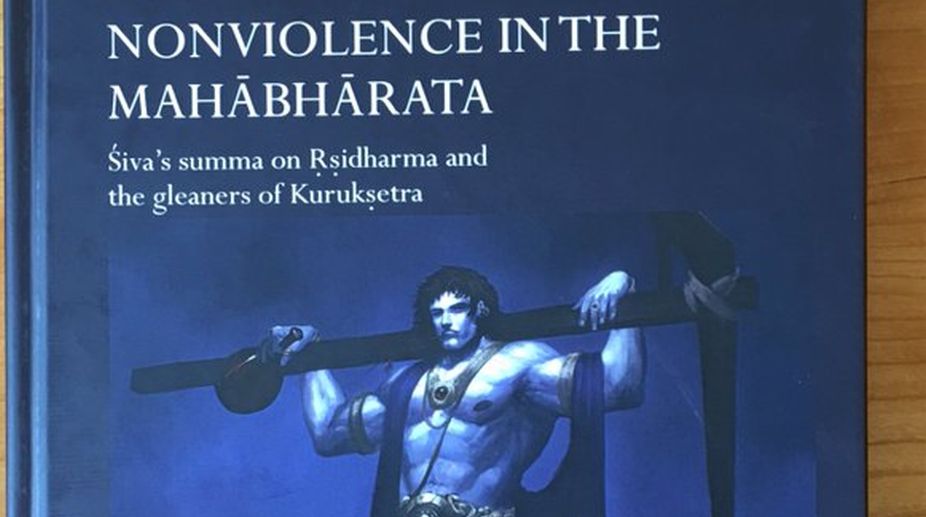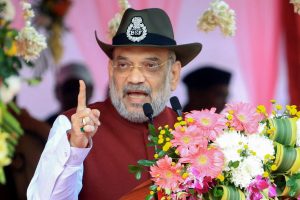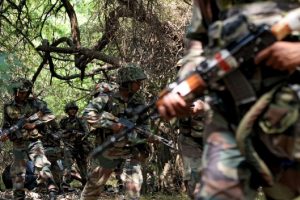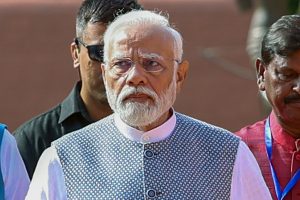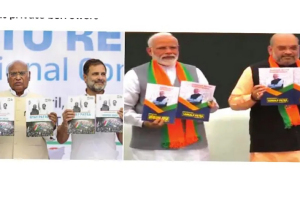Hiltebeitel has been keenly interested in parts of the Mahabharata (MB) usually considered tedious philosophical discourses added in later times.
The discovery of the Spitzer manuscript in the Qizil caves of Xinjiang (circa 100-300 BCE) in Brahmi listing the parvas of the MB (except Anushasana and possibly Virata) indicate that Shanti Parva was then part of the MB. Its “Narayaniya” portion has engaged Hiltebeitel’s research in depth. His latest book focuses on how unchavritti, gleaning (including “non-eaters”), is celebrated in the context of peace and nonviolence, how it features in Buddhist and Jain texts, Anandavardhana’s view that the dominant aesthetic sentiment (rasa) of the epic is shanta, serenity, and Mahatma Gandhi’s interpretation of the epic in terms of ahimsa.
Anirudh Sainath’s painting of Balarama makes a striking cover for the book. What sparked off this new area of research was his operation during which nutrition was supplied through a tube in his stomach, so that he chewed nothing. That set off the trend of thought about ascetics who lived by gleaning leaves, fire, water, air, or ate nothing. This reminds one of Professor P Lal who documented his near-death-experience at length in Lessons and was spurred into resuming his sloka-by-sloka transcreation of the Mahabharata.
To Hiltebeitel, “gleaning is a metaphor for the MB poets’ art” who took material from texts, oral and written, leaving traces in “rough joins” between units. This included a Greek repertoire (Fernando Wulff’s thesis, which can be turned on its head — Greeks borrowing from the Indian epic repertory). Gleaning also symbolises the heterogeneity of the MB encompassing six elements — the main story, frame narratives, authorial interventions, didactic material, side-tales and bhakti matter. The gleaners practise ahimsa, the obverse of the MB, which seems to be all about war (Akbar named its Persian translation Razmnama, Book of War).
Imagining the gleaners as “spectral presences” on the corpse-littered Kurukshetra, Hiltebeitel makes the important point that the Shanti Parva does not signify peace after the carnage. Shanti is “calm of mind, all passion spent,” necessary for enabling the demoralised Dharmaraja to rule. Hiltebeitel holds that the origins of ahimsa lie not in Vedic tradition but in Jainism and Buddhism. Yet, both epics criticise hunting as one of the four royal vices leading to disaster. In the Mokshadharma Parva, Uparichara Vasu is condemned by rishis for interpreting sacrifice as animal, not crops. Yet, eating meat is not criticised.
MB has several tales in the Sankhya and Yoga traditions upholding non-killing of animals. During the forest exile rishi Lomasha recounts the story of the virtuous vegetarian hunter who sells meat and teaches a Brahmin moksha-dharma enunciating, ahimsaparamo dharma, “Non-harming is the supreme way of life.”This phrase occurs first in the Pauloma Parva as an expedient spouted by a non-poisonous snake about to be killed by rishi Ruru. The hunter goes on to criticise Jains, since “who in the world does not hurt something,” even cultivators.
This is what the MB’s heterogeneity signifies. Ahimsa is absent in the Upanishads and appears as “na druhyed” (let him not hurt) in the Dharmashastras, particularly in Baudhayana which has passages similar to the MB’s about forest ashramites and gleaners, as does Manusmriti. The oldest Dharmasutra, Apastamba, speaks about gleaning.
Hiltebeitel suggests that the deer who addresses the ascetic Satya in the Mokshadharma Parva is actually the god Dharma who declares that sacrifice byahimsais superior. It is interesting that Hiltebeitel relies on this story which the Critical Edition (CE) omits. He suggests that the commentator Nilakantha inserted this tale.
A list of all gleaner and forest ashramites mentioned in Shiva’s address to Uma in the Anushasana Parva has been provided from both the Northern (N) and the Southern (S) recensions, the latter wholly revising the former. Hiltebeitel posits that N dates from 200 to 50 BCE and S is much later but before 300 BCE. Shiva mentions types of ascetic gleaners (Nine in N but 13 in S) who follow what Uma calls “rishidharma,” a synonym for moksha-dharma.
Buddhists did not espouse gleaning. Buddha states in the Kukkuravatika Sutta (Majjhima Nikaya) that the ascetic following “govrata” (living like an ox) and a naked one living like a dog off food cast on the ground will be reborn as an ox and as a dog. Jain texts state that such living leads to animal birth.
The Jain advocacy of fasting and staying motionless has a parallel in the MB’s gleaners who observe vows reducing the quantity of food and remaining fixed in dhyana. Hiltebeitel argues that the Dandaka forest is to the Ramayana what Kurukshetra is to the MB, “the great contested battle terrain within India.”
The Dandaka rishis practise ahimsa. Hence they do not kill the Rakshasas, leaving that to Rama. Balarama on his pilgrimage to Kurukshetra passes through forests full of ahimsrair nribhir, men who do no harm. Rama, in ascetic guise, slays Rakshasas whereas Balarama refuses to fight at Kurukshetra. He reaches it carrying the plough, an agricultural implement, linking him to Kuru who ploughs at Samantapanchaka. In this parva, Balarama is frequently called Langalin and Halayudha, plough-wielder.
This is significant as he is famous as the master mace-wielder. Balarma’s pilgrimage is examined in detail to explore three hypotheses — the relationship between the N and the S recensions; the link with the UmaMaheshvara dialogue; and the composition of the MB by Brahmin poets of the Kurukshetra familiar with its gleaners’ folklore.
Hiltebeitel finds that in some cases the S preserved archaic readings of the N. He bases this on TP Mahadevan’s research about the Purvashikha Brahmins of Panchala composing the MB and bringing it south during the Sangam era (300-100 BCE).
The Kalabhra interregnum around 300 BCE led to one branch (the Nambudiris) leaving for Kerala carrying a copy of the S from which the MB in Malayalam script was written, preserving its basic features unlike the Grantha and the Telegu versions. Therefore the CE needs to be based upon collating the S with the N text. The Choliya branch stayed back in Tamil Nadu with a copy of the S. That was added to from the seventh century onwards by the Aparashikha Brahmins migrating to the south. All this makes Gupta datings of the MB impossible.
“Only N is really the text; S is already the tradition…our second MB with a lot of changed words…more systematically brahmanical…in south India where the Guptas were never even in the picture.” In examining the Jaigishavya-Asita Devala tale, Hiltebeitel refers to spirits of ancestors making two “fateful interventions” — of Jaratkaru and Uparichara Vasu. There is a third one, Agastya’s, leading to the story of Lopamudra which, along with that of Madhavi, is a remarkable portrayal of the assertion of feminine independence. Hiltebeitel concludes the MB poets invented Kuru and his parents Samvarana and Tapati, who do not feature in Vedic literature. He proposes that the name may be a toponym or refer to an activity like ritual ploughing.
Significantly, Buddha’s father Suddhodana’s ploughing impels Siddhartha to meditate on the cycle of eating-andbeing-eaten. Even Janaka finds Sita during ritual ploughing. The book concludes with the proposition that whereas the gleaners in the forests call upon Rama to follow his dharma and defeat the Rakshasas to restore peace, those in Kurukshetra are only concerned with achieving liberation through heroic renunciation.
Through their rishidharma they attain inner peace that lies beyond dharma and adharma. It is the merging with the transcendent self, which Krishna speaks of in chapter 14 of the Bhagavad Gita.
(The reviewer is a retired IAS officer and specialises in comparative mythology)

